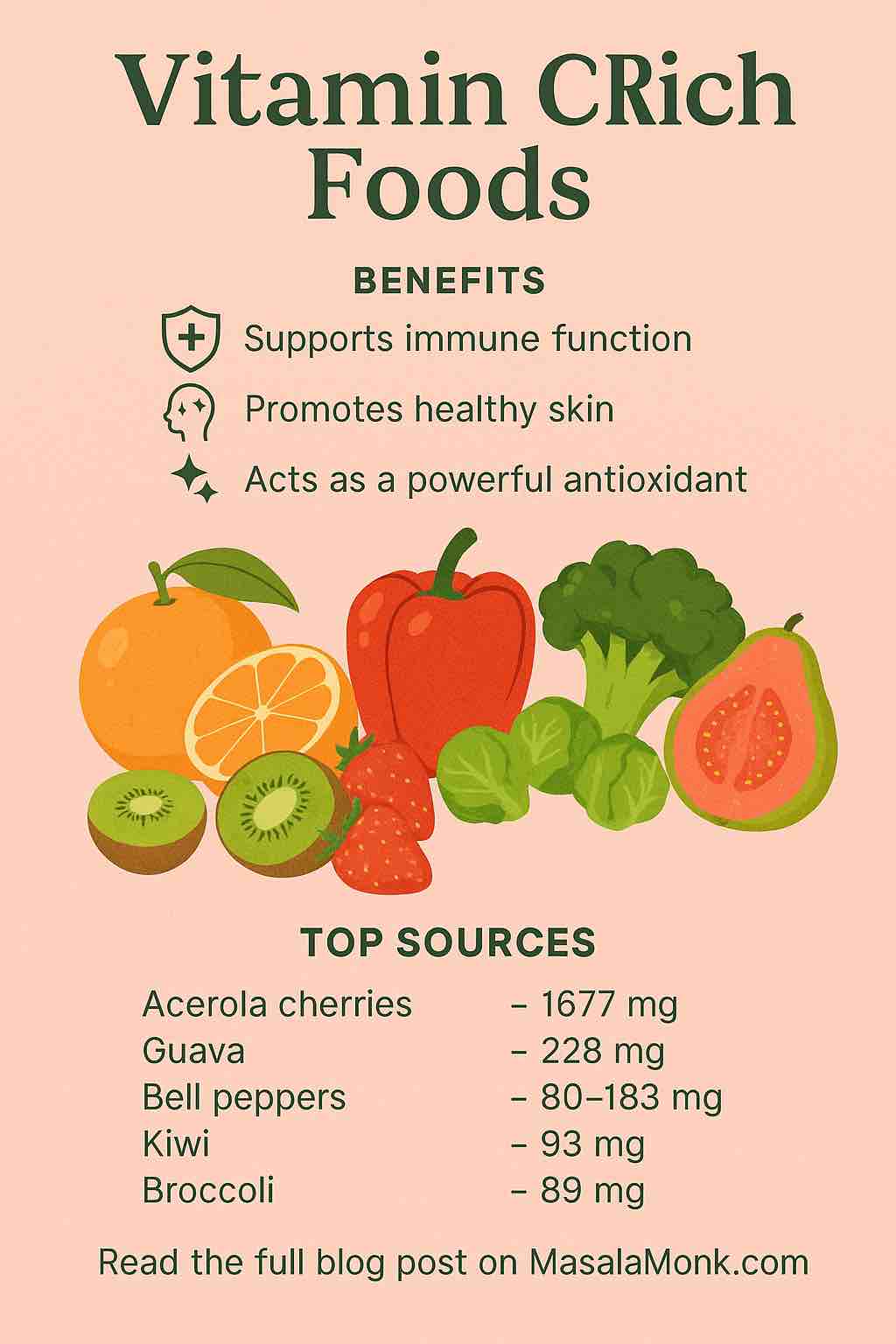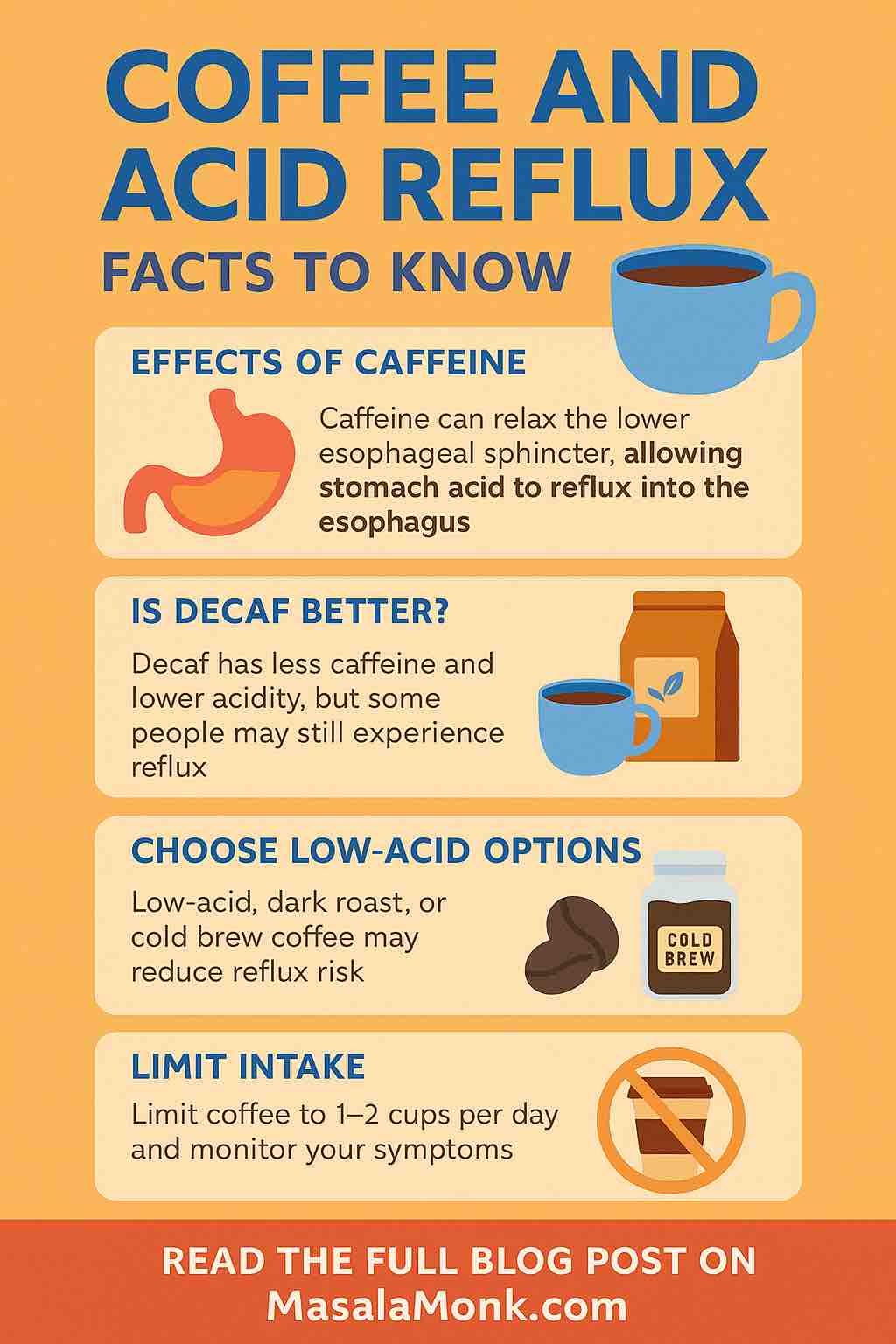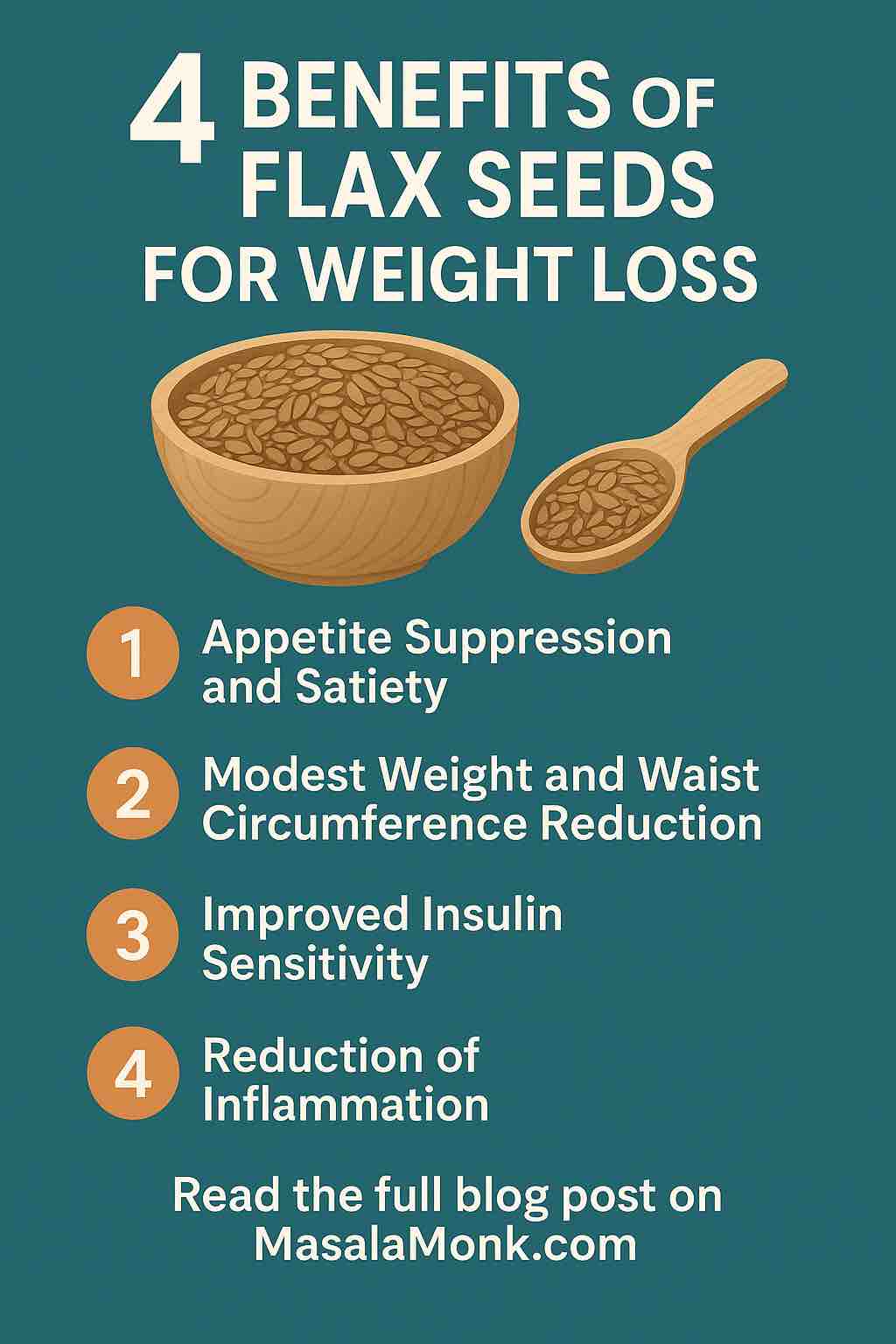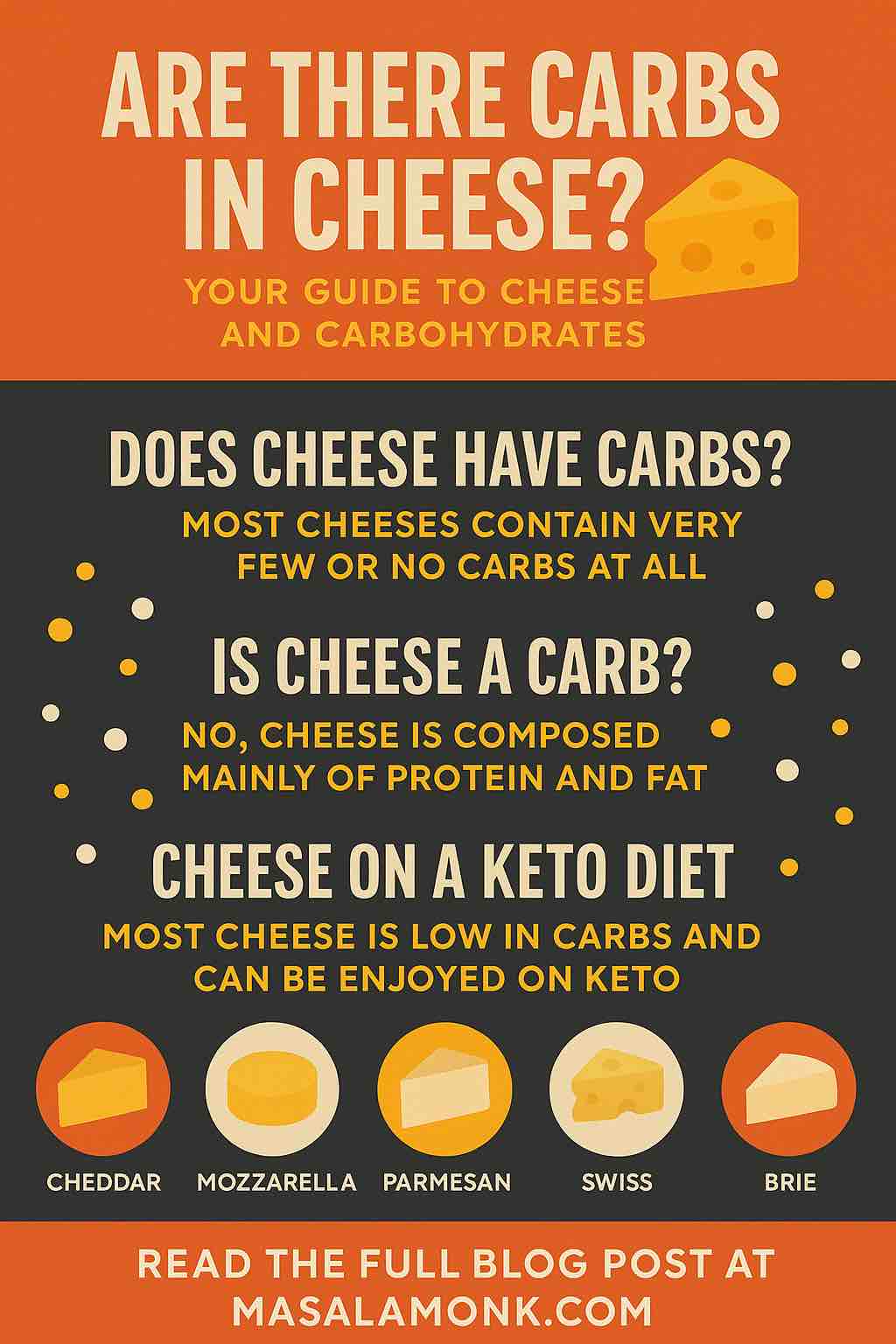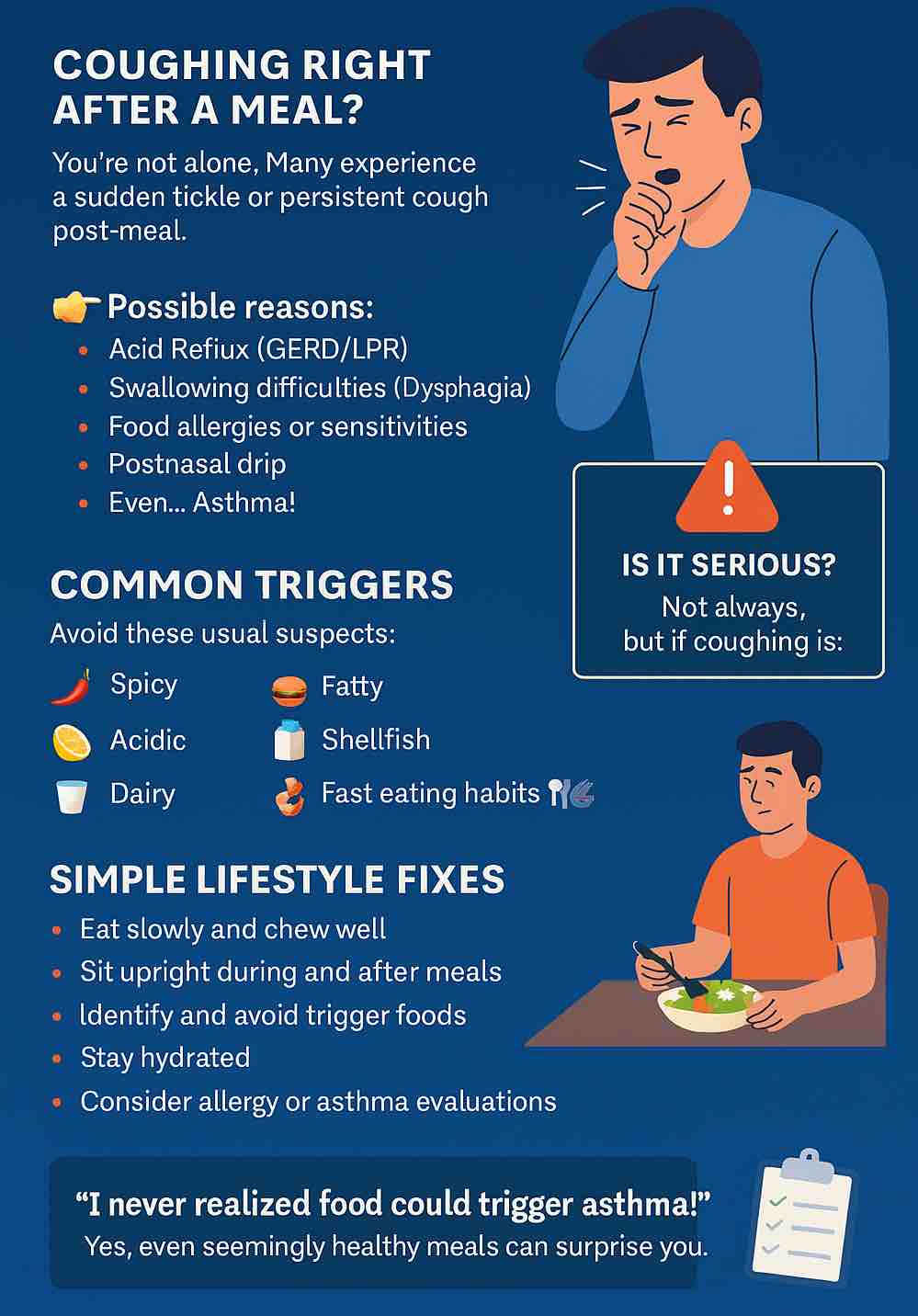
Have you ever finished a meal only to be hit by an annoying cough? If you find yourself coughing consistently after eating, you’re not alone. Many people experience this frustrating symptom, but what causes it? And more importantly, what can you do about it?
In this detailed guide, we’ll explore the top reasons why you cough after eating, explain the underlying causes, and share effective tips to help you stop coughing so you can enjoy your meals without discomfort.
😤 Why Am I Coughing After Eating?
It’s more common than you think. Let’s find out what’s causing it and how to stop it.
🔍 Explore the Common Causes
🧪 Acid Reflux / GERD / LPR
Stomach acid can travel up and irritate your throat, triggering coughs especially after fatty, spicy, or acidic meals.
🌬️ Aspiration or Difficulty Swallowing (Dysphagia)
Food or liquid accidentally entering the airway causes protective coughing. Often seen in older adults or those with neurological conditions.
🌿 Allergies or Postnasal Drip
Mucus from the sinuses can irritate your throat, especially after meals. Watch out for dairy, nuts, and shellfish as common triggers.
😤 Asthma Triggered by Food
Certain foods or preservatives may trigger asthma symptoms, especially in sensitive individuals.
💊 Medication Side Effects
Some blood pressure meds (like ACE inhibitors) cause persistent coughs — check with your doctor if it started after a new prescription.
🧠 Mini Symptom Checker
Answer a few quick questions:
1️⃣ Do you cough more after spicy or fatty meals?
2️⃣ Do you feel food gets stuck or choke while swallowing?
3️⃣ Do you also experience wheezing or shortness of breath?
💡 Smart Habits to Reduce Coughing
- 🕒 Eat slowly and chew thoroughly
- 🪑 Stay upright for 30+ minutes after meals
- 🚫 Avoid known trigger foods or allergens
- 💧 Sip warm water instead of cold drinks
- 📒 Track your symptoms in a food journal
Still curious about what’s going on?
👉 Read the Full Blog on MasalaMonk.comWhat Is Postprandial Coughing?
Postprandial coughing means coughing that occurs after eating. It can range from a mild tickle in your throat to severe bouts of coughing that interrupt your meal. Sometimes this cough comes with phlegm or mucus, making it even more uncomfortable.
Understanding why this happens is the first step to getting relief.
1. Gastroesophageal Reflux Disease (GERD) and Laryngopharyngeal Reflux (LPR)
One of the most common causes of coughing after eating is acid reflux. GERD happens when stomach acid flows back into your esophagus, irritating the lining. In some cases, this acid reaches your throat or voice box, a condition known as LPR.
Even if you don’t feel classic heartburn, acid reflux can cause a chronic cough after meals because the acid irritates your airway.
What to do:
- Avoid spicy, fatty, or acidic foods.
- Eat smaller meals.
- Don’t lie down immediately after eating.
- Talk to your doctor about medications like antacids or proton pump inhibitors.
2. Aspiration and Dysphagia (Difficulty Swallowing)
Aspiration occurs when food or liquid accidentally enters your airway instead of your esophagus, triggering a protective cough to prevent choking.
People with dysphagia, or trouble swallowing, are more prone to aspiration. This can happen due to neurological disorders, aging, or structural abnormalities.
What to do:
- Eat slowly and chew thoroughly.
- Avoid talking while eating.
- If symptoms persist, consult a speech therapist or doctor for evaluation.
3. Food Allergies and Sensitivities
Certain foods may trigger allergic reactions or sensitivities, leading to coughing, throat irritation, or production of mucus after meals.
Common allergens include dairy, nuts, shellfish, and gluten. If you notice coughing linked to specific foods, it’s wise to seek allergy testing.
What to do:
- Identify and avoid trigger foods.
- Carry allergy medication if prescribed.
- Consult an allergist for a proper diagnosis.
4. Postnasal Drip and Sinus Issues
After eating, some people experience increased mucus production from the sinuses that drips down the back of the throat, known as postnasal drip. This mucus irritates the throat, causing coughing.
Allergies, colds, or sinus infections often worsen this condition.
What to do:
- Use saline nasal sprays.
- Manage allergies with antihistamines.
- Stay hydrated to thin mucus.
5. Asthma Triggered by Eating
Asthma doesn’t only affect breathing during exercise or at night—it can sometimes be triggered by eating, especially certain foods or additives.
If coughing after meals accompanies wheezing or shortness of breath, asthma may be a culprit.
What to do:
- Track which foods worsen symptoms.
- Use asthma medications as prescribed.
- Discuss with your healthcare provider.
6. Habitual Fast Eating or Poor Chewing
Eating too quickly or not chewing food well can cause small food particles to irritate your throat or accidentally enter your airway, triggering coughing.
Slowing down can make a big difference.
What to do:
- Take smaller bites.
- Chew thoroughly.
- Pause between bites to swallow properly.
7. Certain Medications
Some medications, including ACE inhibitors for blood pressure, can cause chronic coughing as a side effect that may be noticeable after meals.
If you started coughing after beginning a new medication, check with your doctor.
8. Environmental Factors
Dry or cold air while eating can irritate your throat, especially if you have sensitive airways or allergies.
Eating in humidified environments or drinking warm liquids can help soothe irritation.
9. Psychological Factors
In some cases, chronic coughing can be a habit or related to anxiety, especially when no physical cause is found.
Behavioral therapy or counseling may assist if this is the case.
10. When to See a Doctor
While occasional coughing after eating is usually harmless, see a healthcare professional if you experience:
- Persistent or worsening cough
- Coughing that disrupts eating
- Difficulty swallowing or pain
- Coughing with weight loss or fatigue
- Wheezing or shortness of breath
How to Prevent and Manage Coughing After Eating
- Maintain upright posture while eating and for 30 minutes afterward.
- Avoid trigger foods and drinks like caffeine, alcohol, spicy, and fatty foods.
- Stay hydrated but avoid gulping large amounts during meals.
- Practice mindful eating: eat slowly, chew thoroughly, and savor your food.
- Manage underlying conditions such as GERD, allergies, or asthma with medical help.
Final Thoughts
Coughing after eating is a common but often overlooked symptom that can affect your quality of life. By understanding the causes and implementing lifestyle changes, you can reduce or eliminate this discomfort. If your cough persists, don’t hesitate to seek professional advice—early diagnosis and treatment can prevent complications.
FAQs
1. Why do I cough right after eating?
Coughing immediately after eating can be caused by acid reflux, where stomach acid irritates your throat, or by food or liquid accidentally entering your airway (aspiration). It may also result from allergies or swallowing difficulties.
2. Is coughing after eating a sign of a serious condition?
Not always. Occasional coughing can be harmless, but persistent coughing after meals may indicate conditions like GERD, asthma, or dysphagia, which require medical evaluation.
3. Can acid reflux cause coughing after eating?
Yes. Acid reflux can irritate your esophagus and throat, triggering a cough reflex. This is especially common if reflux reaches the throat (laryngopharyngeal reflux).
4. What foods commonly trigger coughing after meals?
Spicy, fatty, or acidic foods, as well as dairy, nuts, and shellfish, can cause coughing due to reflux or allergies. Identifying and avoiding trigger foods helps reduce symptoms.
5. How can I tell if I have swallowing difficulties causing cough?
If you cough frequently while eating or drinking, feel food getting stuck, or experience choking, you might have dysphagia. A medical assessment can confirm this.
6. Does postnasal drip cause coughing after eating?
Yes. Excess mucus dripping down the back of the throat can irritate it and cause coughing, especially after meals when mucus production may increase.
7. Can asthma cause coughing after eating?
Asthma can be triggered by certain foods or additives and may cause coughing along with wheezing or shortness of breath after meals.
8. When should I see a doctor about my coughing after eating?
If coughing is severe, persistent, causes choking, or is accompanied by other symptoms like weight loss or breathing difficulties, seek medical advice promptly.
9. What lifestyle changes help reduce coughing after meals?
Eating slowly, avoiding trigger foods, not lying down immediately after eating, and maintaining an upright posture can all help reduce coughing.
10. Are there any medications that cause coughing after eating?
Certain medications like ACE inhibitors for high blood pressure may cause chronic coughing. If you notice new coughing after starting medication, consult your doctor.

